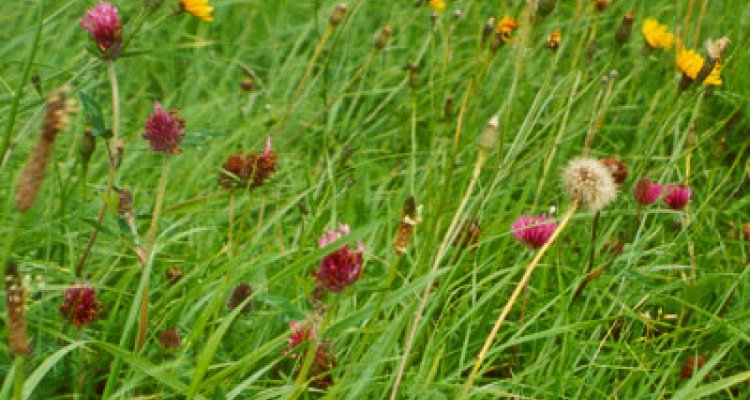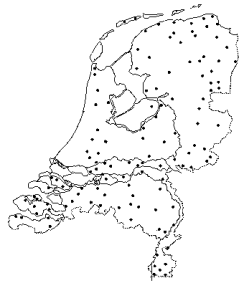
CGN forage crops collection
The CGN forages collection consists at present of 966 accessions of 13 different species: 11 grass species with 703 accessions and two clover species with 263 accessions.
The grass species were received from the former Foundation of Agricultural Plant Breeding (SvP), private breeding firms from The Netherlands (Van Soest and Boukema 1995) and from the collections of Plant Variety Research. Most of the clover accessions were collected by CGN in the Netherlands from 1985 to 1986 (Van Soest and Dijkstra 1986, 1998). The accessions of T. repens were collected in all provinces of the Netherlands. Exploration missions were organised to Uzbekistan (1997, 1999) and Kyrgyzstan (1999). During these missions around 60 forage accessions were collected (Van Soest 1998).
Grasses
The CGN grasses collection consists predominantly of economical important forage grasses cultivated in N.W. Europe. The Lolium collection, including accessions of perennial and Italian ryegrass, forms with 398 accessions the most important collection. This collection includes besides modern cultivars also old cultivars and ecotypes collected in old Dutch pastures.
A study on Lolium perenne carried out by Van Treuren et al. (2005) aiming at the analysis of variation present in populations occurring in old Dutch grasslands with grasslands, in nature reserves and in cultivars using AFLP markers and morphological traits indicated that basically the same range of genetic variation is covered by the three groups, although the reference varieties analysed harboured lesser variation. Therefore it was concluded by Van Treuren et al. (2005) that no specific conservation measures are currently needed to maintain genetic diversity of perennial ryegrass occurring in old Dutch grasslands (the same conclusion could be drawn for white clover as this species was also analysed in this study).
Next to the large Lolium collection there are also a number of smaller collections. The Phleum collection includes two species and consists of 108 accessions, the Festuca collection consists of 75 cultivars of F. rubra, two accessions F. arundinacea and one accession F. pratensis. In the Dactylus glomerata collection 42 accessions are present. the Poa pratensis collection is based upon 76 old and modern Dutch cultivars and 57 accessions collected in 2005 in old Dutch grasslands (Van Treuren 2008). Furthermore there is a small Agrostis cappilaris collection which consists of 11 Dutch cultivars.
Forage legumes

The CGN clover collection consists of 165 white clover (Trifolium repens) and 98 red clover (T. pratensis) accessions. The red clover accessions were mainly obtained during collecting missions in the Netherlands carried out in 1985 and 1986 (Van Soest and Dijkstra 1986, 1998). The collecting sites in all provinces of the Netherlands are presented in Figure 2. Besides the collected ecotypes (N=139), the collection consists of 26 accessions of landraces, cultivars and tetraploid breeding lines. In the group of old landraces there are four old Dutch landraces: Groninger-, Roosendaalse- and Gendringsered clover and Rode Maasklaver. In 1997 and 1998 collecting trips have been organised to all provinces in the Netherlands and some 53 accessions of white clover were collected in old Dutch grasslands. Currently the white clover collection consists of 70 ecotypes and landraces and 28 cultivars amongst which 21 old cultivars from the period between 1924 and 1990.
Next to the clover material from European origin there are 31 accessions from Central Asian origin (Uzbekistan, Kyrgyzstan) collected during 1998 and 1999.
Regeneration
Previously all forage crops were regenerated in specially isolated plots in rye fields. Since 1999 Triticale has been used as isolating crop. Poa pratensis, being apomictic, is not regenerated in isolation plots. The distance between the plots is approximately 50 m. Material that needs vernalisation is kept in unheated greenhouses during the winter. After sowing the seeds in the summer or autumn, some 70 plants are planted in April of the following year in the isolation plots. To prevent lodging, some grass species are staked. Harvest of the seeds is carried out in July/August.
More information on the regeneration of forage crops can be found on the Regeneration section of this page.
References
Van Soest, L. J. M. (1998). Report of expedition to Uzbekistan. Itinerary, collected materials and data. Centre for Plant Breeding and Reproduction Research (CPRO), Centre for Genetic Resources, the Netherlands (CGN), Wageningen, The Netherlands, 34 p.
Van Soest, L. J. M., K. I. Baimatov and V. F. Chapurin (1998). Multicrop collecting mission to Uzbekistan. Plant Genetic Resources Newsletter 116: 32-35.
Van Soest, L. J. M. en I. W. Boukema (eds) (1995). Diversiteit in de Nederlandse Genenbank [Diversity in the genebank of The Netherlands] CPRO/CGN, Wageningen, The Netherlands. 126 p.
Van Soest, L. J. M. and H. Dijkstra (1986). Red clover collecting in The Netherlands. Internal report CGN/SVP. Wageningen, The Netherlands, 3 p.
Van Soest, L. J. M. and H. Dijkstra (1998). Current status of CGN forages collection. In: Maggioni, L. et al. 1998. Report of a working group on Forages. Sixth meeting, 6-8 March 1997, Beitostølen, Norway. IPGRI, Italy: 78-80.
Van Treuren, R. (2008). AFLP fingerprinting of Kentucky bluegrass (Poa pratensis L.) from undisturbed Dutch grasslands: implications for conservation. Plant Genetic Resources Newsletter, 153: 1-8.
Van Treuren, R., N. Bas, P. Goossens, H. Jansen and L.J.M. van Soest (2005). Genetic diversity in perennial ryegrass and white clover among old Dutch grasslands as compared to cultivars and nature reserves. Molecular Ecology, 14: 39-52.